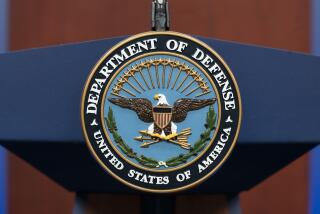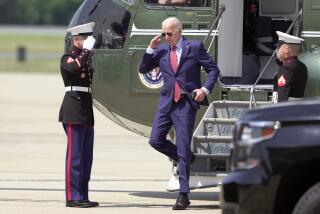Forces sought in Afghanistan
WASHINGTON — A top commander of U.S. forces in Afghanistan said Friday that he needed thousands of additional troops to combat violence along the border with Pakistan, a requirement that appears to be at odds with recommendations from Army Gen. David H. Petraeus on future troop levels in Iraq.
Because of strains on the military, plans to boost the number of troops in Afghanistan depend on reducing the force in Iraq. Petraeus’ plan, which President Bush is expected to approve Tuesday in an appearance at the National Defense University, would slow the reduction of combat troops in Iraq, freeing up only one full Army combat brigade for redeployment to Afghanistan. That move would not happen until early next year.
In addition to the combat brigade of about 3,500 to 4,000 troops, U.S. officials also plan to withdraw about 2,000 non-combat support personnel from Iraq and transfer about 1,300 Marines from Iraq’s Anbar province to western Afghanistan.
Some in the Pentagon had been pushing for a faster and larger reduction of combat forces from Iraq and a more aggressive troop buildup in Afghanistan. They preferred withdrawing as many as three combat brigades so that additional forces could be sent to Afghanistan before the end of the year.
Pressure from U.S. commanders in Afghanistan for more troops has become the central point in a public debate among senior U.S. military officers and a source of tension among Pentagon planners, who are at odds over how quickly to shift forces from an increasingly stable Iraq to an increasingly violent Afghanistan.
Army Gen. Jeffrey J. Schloesser, who took command of American-controlled eastern Afghanistan in April, said that coalition forces were at no risk of losing in Afghanistan without additional brigades. But he said that continuing with the current level of about 34,000 U.S. troops for an extended period would result in a “slow win.”
“It’s not the way that I think the Afghans, the international community and the American people would like to see us conduct this war,” Schloesser said in a video conference with reporters at the Pentagon. “It will take longer, the way we are doing it right now. . . . I’d like to speed that up.”
Petraeus, reluctant to risk hard-won security gains in Iraq, had wanted to maintain troop levels there at 15 brigades through next June, according to a Pentagon official who described the internal deliberations on condition of anonymity.
But under a compromise with the Joint Chiefs of Staff, the first brigade to redeploy from Iraq to Afghanistan -- the 3rd Brigade of the Army’s 10th Mountain Division -- will deploy in February.
U.S. officials say that insurgents and extremist groups use Pakistan’s tribal areas as a base from which to attack foreign forces across the border in eastern Afghanistan. The U.S. targets Islamic militants in the tribal areas with airstrikes by unmanned Predator drones, and this week U.S. commandos conducted a raid into Pakistan, angering the government.
Schloesser said that recent Pakistani military action in the lawless tribal regions has begun to stem some of the bloodshed associated with cross-border attacks.
Still, violence overall in eastern Afghanistan is up 20% to 30% in the first eight months of the year compared with last year, he said.
In July, nine Americans were killed in a coordinated insurgent assault on an isolated outpost in northeastern Afghanistan.
“I think they’re going to decrease the level of activities just because of the tough winter weather that we normally have here in this part of Afghanistan,” Schloesser said.
“But I do believe that the level of significant activities, maybe violence, will be higher than any previous winter since 2002.”
Schloesser said he intended to launch a “winter offensive” in the coming months to prevent extremist groups from regrouping when fighting resumes next spring. But an offensive could be difficult without additional forces, he said.
U.S. commanders in eastern Afghanistan have “very low numbers of troops,” Schloesser said. They are able to attack enemy positions, but not hold captured territory and begin the rebuilding necessary to win in a counterinsurgency effort.
“We’re not losing this war, and we won’t lose if those troops don’t show up in the next several months,” he said. “If we’re going to try to do this in a more timely way and be as effective as I want to be . . . then we’re going to need them, you know, within the winter time-frame.”
A senior military official close to the process said that the Army combat brigade, Marine units and support personnel represent a withdrawal of 7,000 to 8,000 troops from Iraq by February.
“Eight thousand is a pretty significant cut,” said the official, who spoke on condition of anonymity because the recommendations have not been made public.
But whether those withdrawals will provide adequate help in eastern and southern Afghanistan, the two most troubled regions of the country, remains in question.
The 1,300 Marines -- a battalion and helicopter unit -- would be the only combat troops to shift from Iraq this year. However, a senior military official said the Marines were likely to be sent to western Afghanistan in November, not the more turbulent east or south.
They would replace the 2nd Battalion of the 7th Marine Regiment, based in Twenty-Nine Palms. Officials are not planning to replace another Marine contingent in the country’s most troubled area, Helmand province in southern Afghanistan.
In sum, the Marine shifts actually represent an overall decline of about 2,000 U.S. combat troops in Afghanistan. The arrival there in February of the brigade from the Army’s 10th Mountain Division would then amount to a net increase in combat troops.
Adm. Michael G. Mullen, chairman of the Joint Chiefs of Staff, has said his top priority for Afghanistan would be military trainers for Afghan security forces, suggesting a portion of those troops may be assigned to noncombat missions.
White House Press Secretary Dana Perino said Bush had received the military’s recommendation on troop levels during a meeting Wednesday evening with Mullen and Defense Secretary Robert M. Gates, who presented Petraeus’ plan.
“The question on the president’s mind has been: How do we make sure that we cement those gains [in Iraq] and not jeopardize those gains, and be able to continue the process of return on success?” she said.
--
More to Read
Sign up for Essential California
The most important California stories and recommendations in your inbox every morning.
You may occasionally receive promotional content from the Los Angeles Times.










